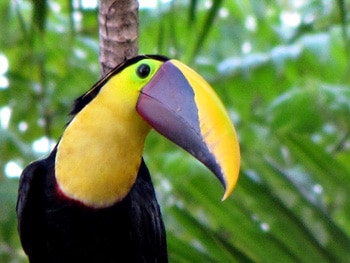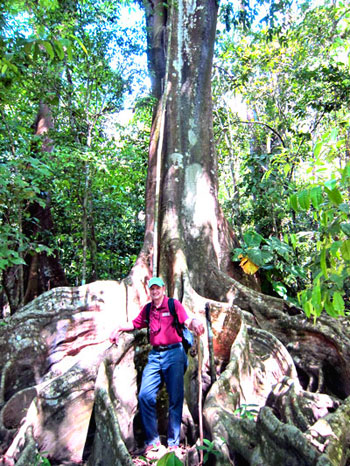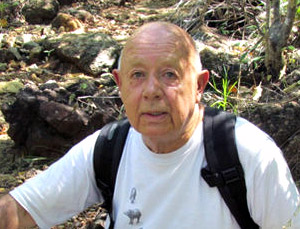
Chestnut-mandibled toucan, Osa Peninsula, Costa Rica.
Photo: Andrew Mace, CC BY-NC-SA 2.0.
Stroud Center Director Bern Sweeney, Ph.D., traveled to Costa Rica in late January to discuss innovative practices in re-wilding tropical ecosystems including rainforests, mangrove forests, streams and wetlands.
THE MOST BIOLOGICALLY INTENSE PLACE ON EARTH
The workshop was held at the Piro Biological Research Station on the Osa Peninsula in Costa Rica. It was organized by Osa Conservation and the Bobolink Foundation and was attended by leading conservation practitioners.
The Osa Peninsula harbors 2.5 percent of the world’s biodiversity in just 700 square miles of forest habitat and coastal marine areas, leading National Geographic to name it “the most biologically intense place on earth.”
PROTECTING WATER, THE LIFEBLOOD OF WILDLIFE

Bern Sweeney, Ph.D., stands among buttress roots of an old growth tree in Corcovado National Park, Osa Peninsula, Costa Rica.
Photo: Jim Palmer
Sweeney’s presentation focused on the importance of forest buffers for improving in-stream habitat and water quality.
Re-wilding tropical ecosystems starts with clean fresh water,” Sweeney told attendees. “Water is the lifeblood of wildlife.”
He further explained that the world population of 7 billion humans, with its growing demands for housing, business and agriculture, stresses the natural environment because these activities replace naturally forested areas.
“Water and habitat quality decline when each piece of forest is traded for human activities,” Sweeney stated, adding that the solution is to “create a little space between the danger of what we are doing and what we are trying to protect by filling it in with native plants — specifically riparian forest buffers.”
Sweeney pointed to an extensive scientific literature review he conducted with Stroud Center colleague Denis Newbold, Ph.D., in which — after reviewing 238 studies — they concluded that 100-foot-wide buffers are needed to protect the physical, chemical and biological integrity of small streams.
At this width, Sweeney said, the review showed that buffers can keep approximately 48 percent of nitrogen from getting into the stream. But the bad news, he added, is that approximately 52 percent of the nitrogen still passes through the buffer into the stream.
FOREST BUFFERS ENHANCE STREAM, LIVESTOCK AND HUMAN HEALTH
Fortunately, forest buffers can also enhance the health of the stream ecosystem itself so that it better processes nutrients such as nitrogen and keeps them from going further downstream where they degrade our large rivers and estuaries.
In addition to ecosystem benefits, Sweeney said, forest buffers benefit landowners by preventing the spread of sediment and cryptosporidiosis (“Crypto”), one of the most common waterborne diseases in the world. He added that a riparian forest will also reduce the number of insect pests on the farm, such as blackflies, which cause livestock infections.
Álvaro Ugalde, Father of Costa Rica’s National Parks System, Dies at 68

Alvaro Ugalde
Photo: E. Carrillo, La Nación
Soon upon his return to the United States, Sweeney was saddened to learn of the death of his friend and conservation colleague Álvaro Ugalde, whom he enjoyed spending time with while in Costa Rica.
Ugalde, a biologist by training, along with Mario Boza, is considered a father of Costa Rica’s world-famous national parks system. He died February 15 of a heart attack at his home.
“Throughout his life, Ugalde worked to preserve Costa Rica’s national parks by teaching people about the benefits of preserving land for future generations,” said Sweeney.
In the 1970s, Ugalde and Boza advanced the idea of converting watersheds into national parks. As a result of their efforts, the first national park, Poás Volcano, was founded in 1970.
In the beginning, Ugalde and Boza had trouble selling the idea because many saw the national parks as unaffordable luxuries for a developing nation. However, decades later, after millions of visitors made tourism the primary source of foreign exchange income for the country, the value of the parks as a magnet for tourists became apparent.
Conservationists are trying to carry out their vision of connecting the parks by “corridors” of protected areas that would guarantee the preservation of gene pools for the many species endemic to Costa Rica. Now, a total of 166 protected areas, both public and private, safeguard Costa Rica’s natural resources.
Stroud Water Research Center sends its condolences to Ugalde’s family, friends and colleagues.



